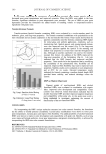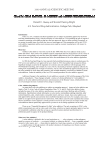ALTERNATIVES TO COSMETICS PRESERVATION 123 (3) A. Varvaresou, S. Papageorgiou, E. Tsirivas, E. Protopapa, H. Kintziou, V. Kefala, and C. Dementzos, Self-preserving cosmetics, Int. J. Cosmet. Sci., 31, 163–175 (2009). (4) L. Leistner, Basic aspects of food preservation by hurdle technology, Int. J. Food Microbiol., 55, 181–186 (2000). (5) W. Petersen, Antimicrobial ingredients for self-preserving cosmetics, Euro Cosmetics, 2/99, 28–36 (2002). (6) J. J. Kabara and D. S Orth, Preservative-Free and Self-Preserving Cosmetics and Drugs: Principles and Practice (Marcel Dekker, New York 1997). (7) T. Mangena and N. Y. Muyima, Comparative evaluation of the antimicrobial activities of essential oils of Artemisia afra, Pteronia incana and Rosmarinus offi cinalis on selected bacteria and yeast strains, Lett. Appl. Microbiol., 28, 291–296 (1999). (8) N. Y. O. Muyima, G. Zulu, T. Bhengu, and D. Popplewell, The potential application of some novel essential oils as natural cosmetic preservatives in an aqueous cream formulation, Flav. Fragr. J., 17, 258–266 (2002). (9) K. A. Hammer, C. F. Carson, and T. V. Riley, Antimicrobial activity of essential oils and other plant extracts, J. Appl. Microbiol., 86, 985–990 (1999). (10) L. Pianizzi, G. Flamini, P. L. Gion, and I. Morelli, Composition and antimicrobial properties of essential oils of four Mediterannean Lamiaceae, J. Ethnopharmacol., 39, 167–170 (1993). (11) I. Manou, L. Bouillard, M. J. Devleeschouwer, and A. O. Barel, Evaluation of Thymus vulgaris essential oil in topically applied formulations under challenge test, J. Appl. Microbiol., 84, 368–376 (1998). (12) A. M. Maccioni, C. Anchisi, A. Sanna, C. Sardu, and S. Dessi, Preservative systems containing essential oils in cosmetic products, Int. J. Cosmet, Sci., 24, 53–59 (2002). (13) C. F. Carson and T. V. Riley, Antimicrobial activity of the essential oil of Melaleuca alternifolia, Lett. Appl. Microbiol., 16, 49–55 (1993). (14) C. F. Carson and T. V. Riley, Antimicrobial activity of the major components of the essential oil of Mela- leuca alternifolia, J. Appl. Bacteriol., 78, 264–269 (1995). (15) J. J. Kabara, D. M. Swieczkowski, A. J. Conley, and J. P. Truant, Fatty acids and derivatives as antimi- crobial agents, Antimicrob. Agents Chemother., 2, 23–28 (1972). (16) G. Bergasson, J. Arnfi nnsson, Ó. Steingrìmson, and H. Thormar, In vitro killing of Candida albicans by fatty acids and monoglycerides, Antimicrob. Agents Chemother., 45, 3209–3212 (2001). (17) L. Rigano and R. Leporatti, Systemic canstellations: With or without preservatives? SÖWF J., 129, 1–9 (2003). (18) J. Jänichen, The quest for the ideal preserving system-reducing traditional preservatives in combination with Dermosoft Octiol. Euro Cosmetics, 7/8, 10–16 (2004). (19) Dr Straetmans Formulary 2005. E-mail info@dr-straetmans.de. (20) J. B. Hinou, C. E. Harvala, and E. B. Hinou, Antimicrobial activity screening of 32 common constitu- ents of essential oils, Pharmazie., 44, 302–303 (1989). (21) J. M. Blakeway, Fragrances as preservatives, SÖFW J., 116, 357–359 (1990). (22) M. Sautour, A.-C. Mittanine-Offer, and M.-A Lacaille-Dubois, The Dioscorea genus: A review of bioac- tive steroid saponins, J. Nat. Med., 61, 91–100 (2007). (23) A. C. Dweck, Natural preservatives, Cosmet. Toiletr. 118, 45–50 (2003). (24) B. Kong, J. Wang, and Y. L. Xiong, Antimicrobial activity of several herb and spice extracts in culture medium and in vacuum-packaged pork, J. Food Prot., 70, 641–647 (2007). (25) Plantservative® WSr, Technical Specifi cations, Campo Cosmetics S Pte. Ltd, Singapore. (26) M. Oskay and D. Sari, Antimicrobial screening of some Turkish medicinal plants, Pharm. Biol., 45, 176–181 (2007). (27) L. E. Anelich and L. Korsten, Survey of microorganisms associated with spoilage of cosmetic creams manufactured in South Africa., Int. J. Cosmet, Sci., 18, 25–40 (1996). (28) R. Campana, C. Scesa, V. Patrone, E. Vittoria, and W. Baffone, Microbiological study of cosmetic prod- ucts during their use by consumers: Health risk and effi cacy of prservative systems, Lett. Appl. Microbiol., 43, 301–306 (2006). (29) L. Thomas, A. D Russell, and J.-Y. Maillard, Antimicrobial activity of chlorhexidine diacetate and benzalkonium chloride against Pseudomonas aeruginosa and its response to biocide residues, J. Appl. Microbiol., 98, 533–543 (2005). (30) T. Thorsteinsson, T. Loftsson, and M. Masson, Soft antibacterial agents, Curr. Med. Chem., 10, 1129– 1136 (2003).
Purchased for the exclusive use of nofirst nolast (unknown) From: SCC Media Library & Resource Center (library.scconline.org)





































































































































